While KitchenAid is perhaps best known for its iconic, wildly-popular tilt-head and bowl-lift stand mixers—which are available in over 40 yummy colors – the company’s foray into the crowded espresso machine market appears to have been a good move.
The black color might not photograph well in my kitchen, but the KitchenAid Semi-Automatic Espresso Machine is simply beautiful. Many espresso makers with this many features tend to be big and bulky, but KitchenAid created a streamlined machine that still packs all of the punches expected at this price range.
From the adjustable burr grinder to the four filter baskets, it feels high-end. There’s also a pressure gauge, steam wand, milk pitcher, tamper, priming pump, and cleaning brush.
KitchenAid included everything needed for at-home baristas. But how does it compare to the best espresso machines and other coffee makers available? Keep reading to find out.

Terri is a freelance writer living in Birmingham, AL. She has tested hundreds of products, including kitchen appliances, vacuums, bedding, furniture, luggage, and tech gear. Terri has bylines at Architectural Digest, Forbes, Popular Science, CNN Underscored, NBC News, The Daily Beast, USA Today, US News & World Report, Tech Radar, Homes & Gardens, and Tom's Guide. Follow her adventures @Territoryone.
Terri drinks (decaf) coffee daily and has tested the KitchenAid Semi Automatic Espresso Machine for over a month, evaluating design, user-friendliness, flavor, and consistency. She was allowed to keep it for ongoing use.
KitchenAid Semi-Automatic Espresso Machine: Price & availability
The KitchenAid Semi-Automatic Espresso Machine retails on Amazon for $699.99, and is currently on sale for $549.99 . It’s the exact same retail and sale price on the KitchenAid website at the time of publication. The $150 discount makes it easier to consider if you're on a tight budget.
However, even when it's not on sale, the various features (including the integrated burr grinder and steam wand) make this a worthwhile investment for those who love espresso drinks—and can afford it.
Score: 4 out of 5
KitchenAid Semi-Automatic Espresso Machine : Setup
The KitchenAid Semi-Automatic Espresso Machine arrived in a brown cardboard box, and inside of that was the branded KitchenAid box. The machine was securely packaged and the various components were well-cradled to protect from breakage and scratches. I test a lot of coffee and espresso makers, and it's usually quite a tedious process trying to remove the machine from the box. However, KitchenAid included cardboard grab handles, which made it infinitely easier to remove the small appliance witout damaging the box.
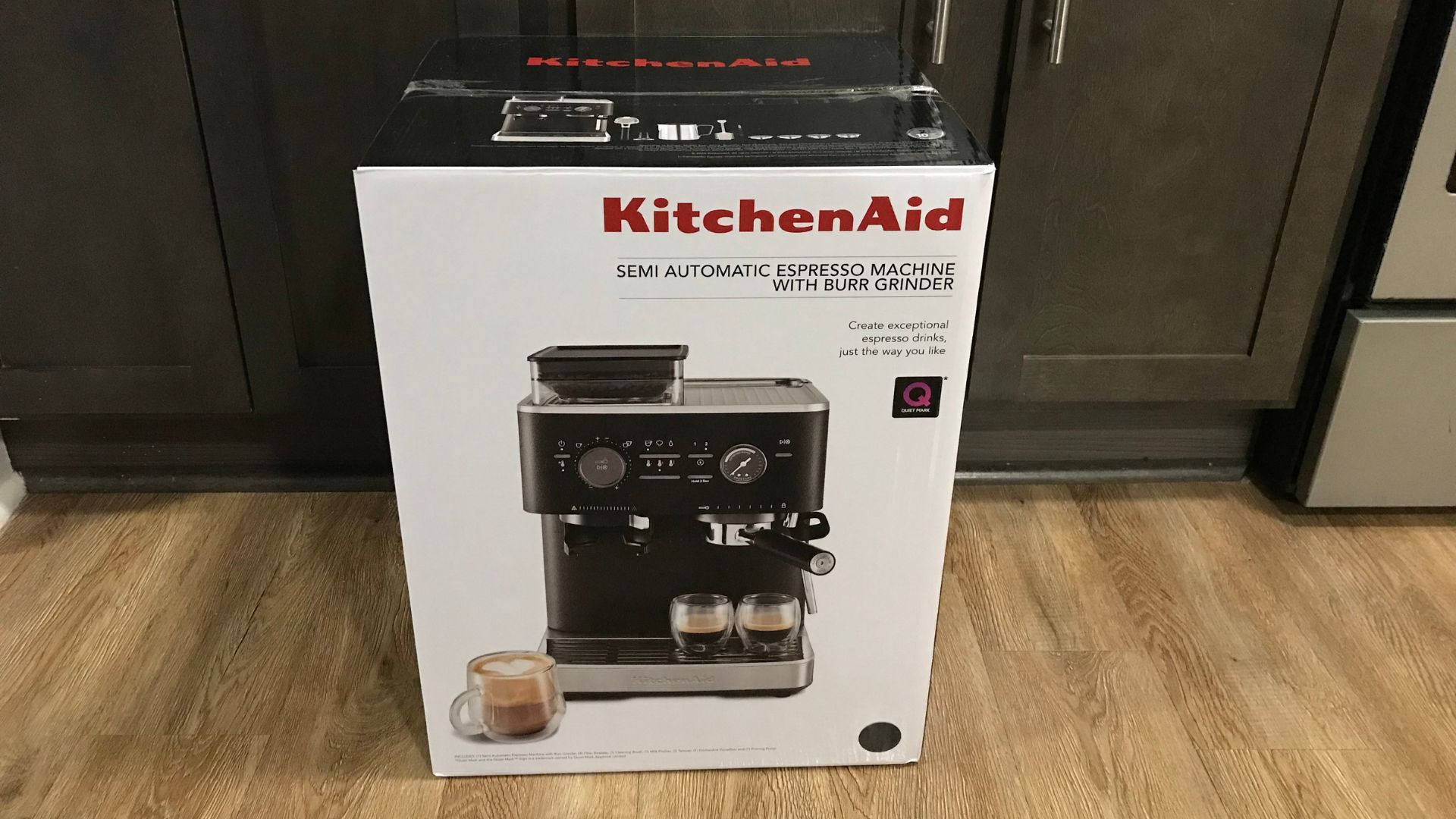
The espresso machine includes a variety of parts and accessories, including a portafilter, 1 shot single wall filter basket, 2 shot single wall filter basket, 1 shot double wall filter basket, 2 shot double wall filter basket, tamper, milk pitcher, priming pump, water filter and water filter holder, and cleaning brush. There’s also an owner’s manual, quick-start guide, and a colorful recipe booklet.
KitchenAid Semi-Automatic Espresso Machine: Design
I love the elegant, streamlined design of the KitchenAid Espresso Machine. I had a choice of colors, and chose the Cast Iron Black (since most of the coffee and espresso machines I test are stainless steel, I wanted a change of pace). However, it’s also available in Candy Apple Red, Juniper, Porcelain White, and of course, Brushed Stainless Steel. The black color proved to be harder to photograph because the pictures don’t do justice to the gorgeous matte black finish.
The generous water tank holds 84.5 ounces, so there’s no need to keep refilling it. The water tank is also removable, which makes it easier to fill and empty. The cup warming tray on top can be used to preheat your cup or glass mug. In addition, the integrated burr grinder can be adjusted for coarser or finer grind sizes. Yet another feature is the adjustable temperatures: low, medium, or high. There's also steam mode to heat and froth milk, and a hot water setting.
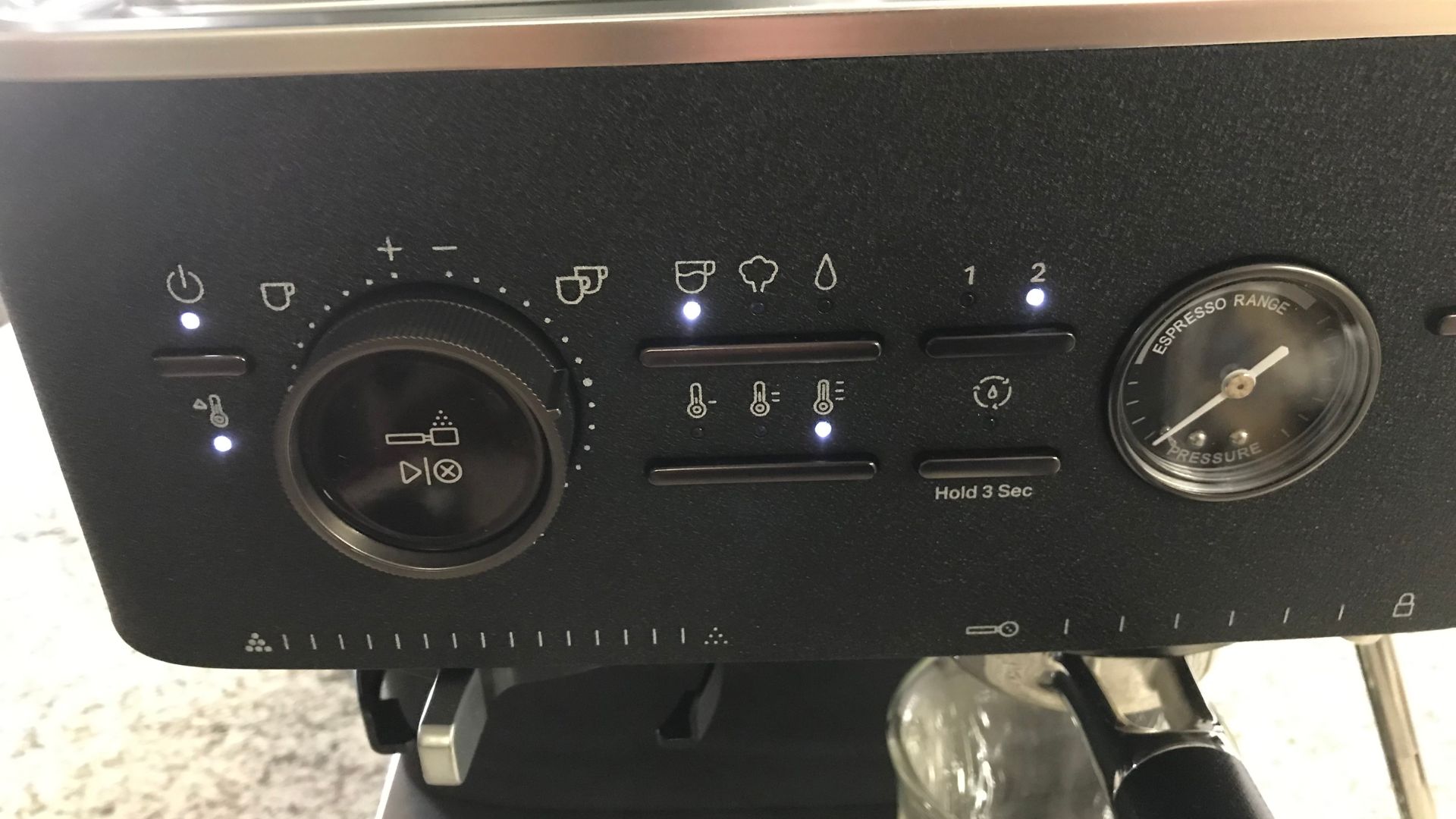
The control panel consists of the Grind Start/Stop, Grind Amount Select, Heating Light Indicator, Power Button, Mode (Espresso, Steam, Hot Water), Dose (1 shot or 2 shots), Pressure Gauge, Start/Stop Brew, Clean Cycle, and Temperature.
The LED comes on when grinding coffee and also when brewing coffee, which helps me to see what I’m doing in those tight spaces.
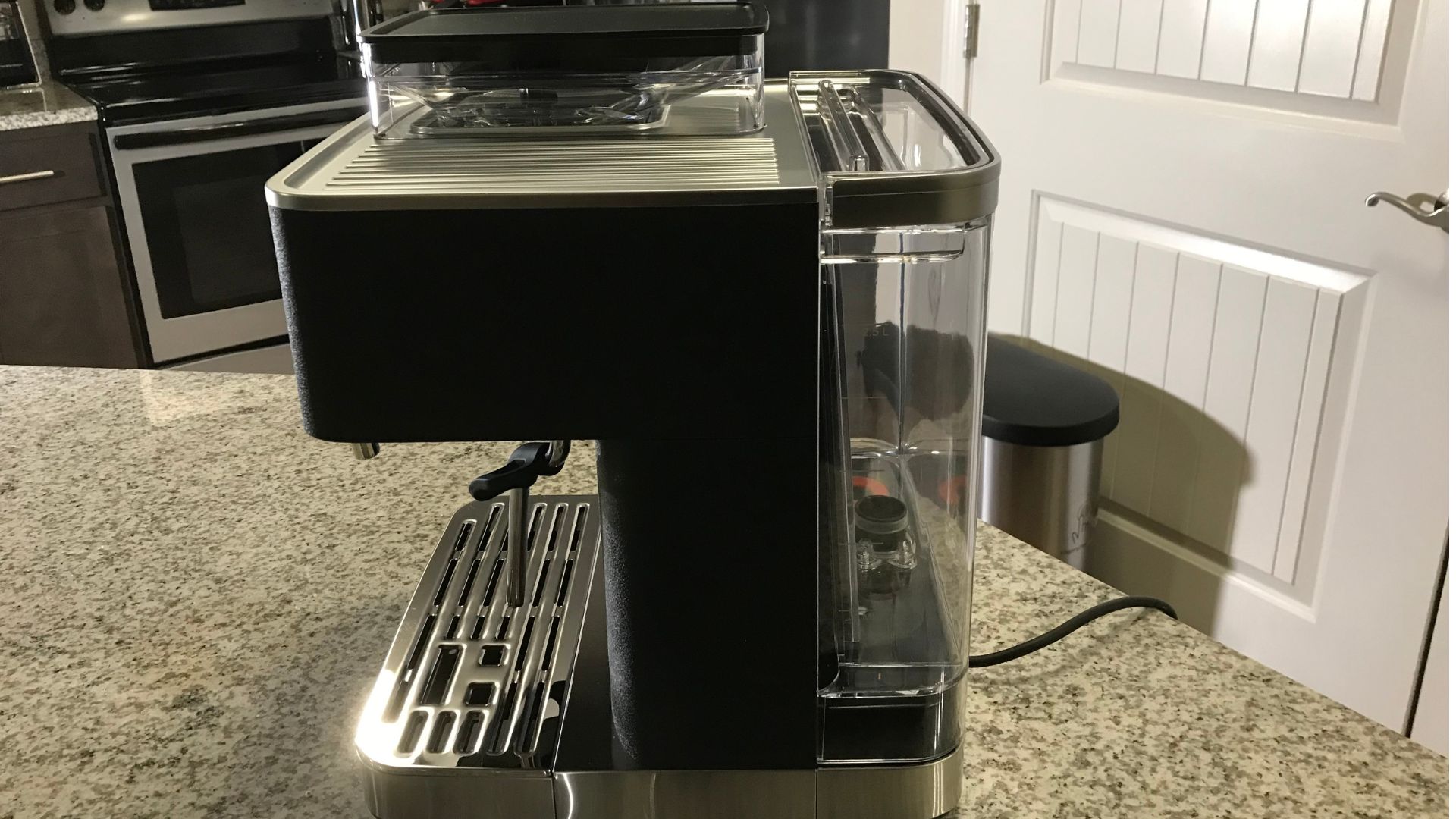
The espresso machine looks, feels, and functions like a high-end machine.
Score: 4.5 out of 5
KitchenAid Semi-Automatic Espresso Machine: Key specs
| Row 0 - Cell 0 | Row 0 - Cell 1 |
| Type | Espresso |
| Capacity | 40 ounces |
| Grinder? | Yes |
| Frother? | Yes |
| Dimensions | H15.3 x W13.1 x D11 inches |
KitchenAid Semi-Automatic Espresso Machine: Performance
After unpacking the KitchenAid Espresso Machine, I washed all of its parts, and filled the water tank. However, I did not run my customary cycle to flush out any dust or dirt - at least not yet.
One of the included accessories in a Priming Pump, a plastic injector, which (per instructions) is pressed, dipped into the water tank, and then removed from the water tank and inserted the Priming Pump in the Water Tank Connector. Then I pressed and held the Temperature Button until the rest of the buttons on the machine lit up. This engages the priming process, and the water in the pump came out of the machine (into a mug that I’d placed under the water spout).
Then, I ran a cycle to remove any dust or debris from the manufacturing process.
My first test was to make an espresso drink using coffee beans. I filled the hopper with beans, selected a grind size, and then selected a filter basket. This was a slightly confusing process, since I’m accustomed to 2 basket types and there were 4 to choose from (1 shot single wall filter basket, 2 shot single wall filter basket, 1 shot double wall filter basket, 2 shot double wall filter basket). The first two are for freshly ground whole bean coffee, and the latter two are for regular ground coffee.
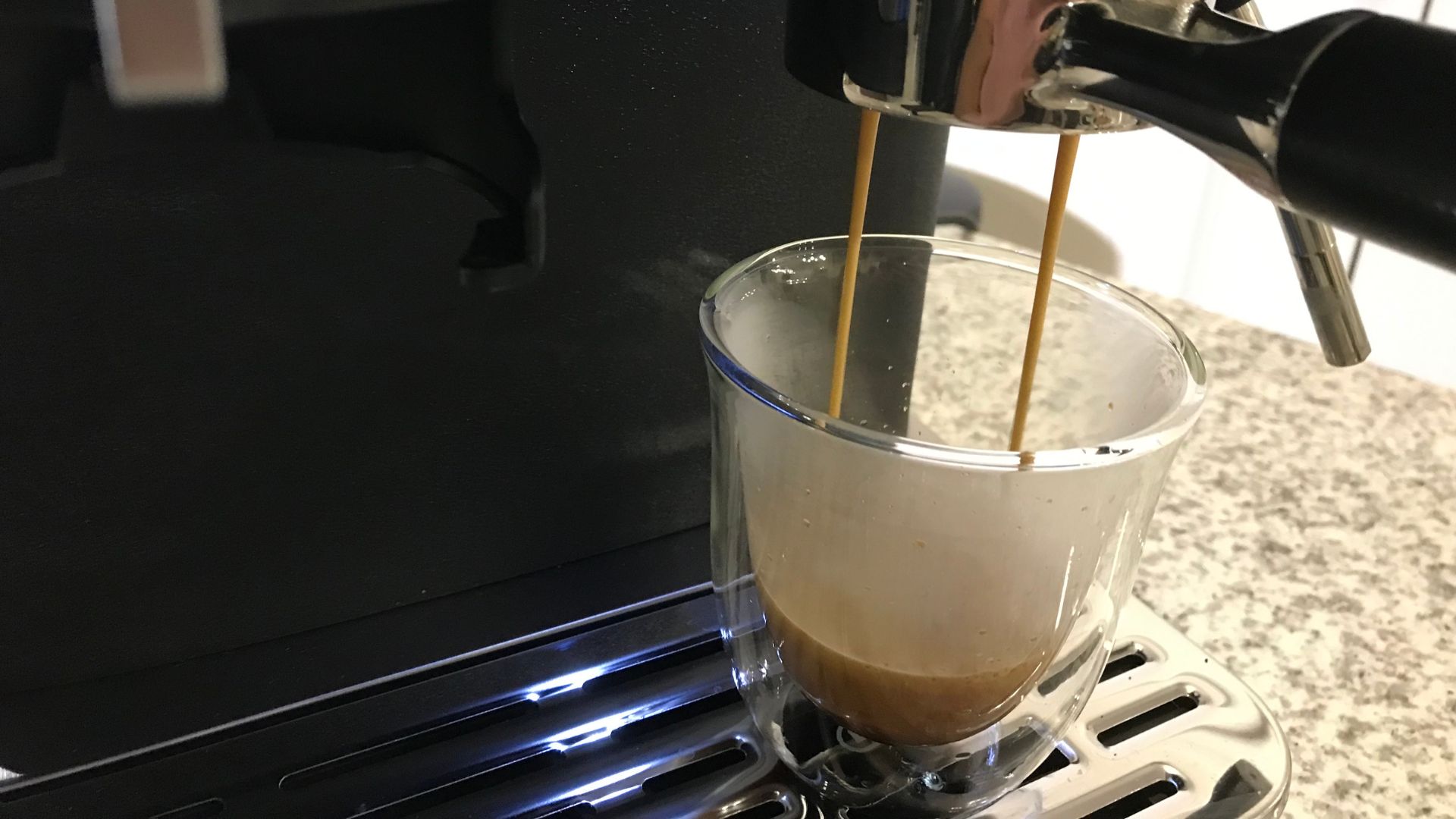
However, I could not immediately tell which basket type I needed, and had to refer to the manual to distinguish between them. I later discovered that there are engravings on the side of each filter basket that identify the type. However, I never quite reached the point where I could just look at a basket and determine which type and size it was without searching for the engraved text or looking at the manual.
Sometimes, when grinding coffee beans, I would think I’d chosen the wrong filter basket type or size because it would look like I was going to overflow the basket – but that never happened. Then I would use the tamper to tamp down the ground coffee. The next step was to move the Portafilter under the Group Head, and then select my preferred number of shots. I could also select the temperature (low, medium, high). The coffee was rich and full-bodied and included a luscious crema layer.
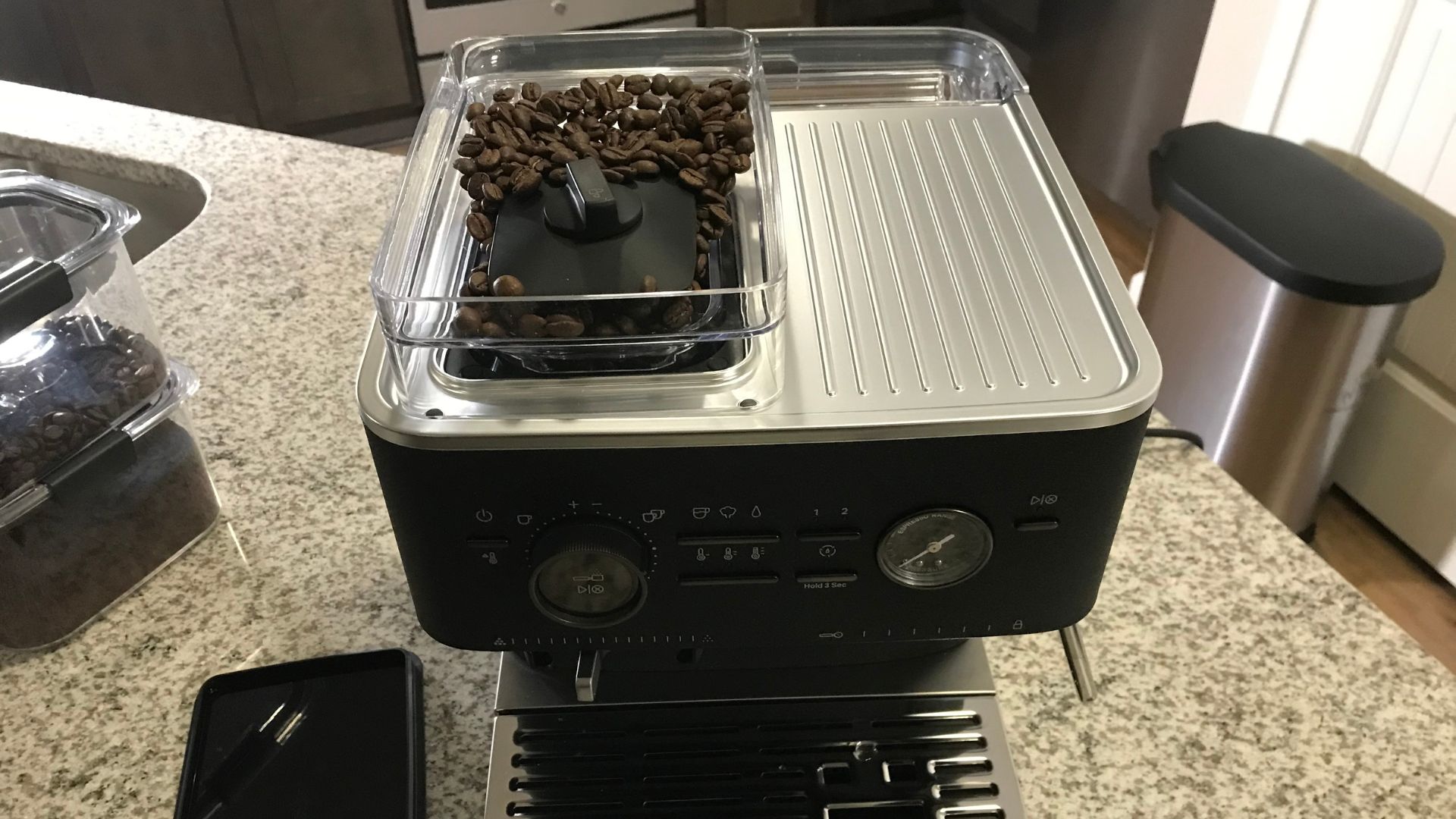
I used the steam mode to froth milk in the stainless-steel milk pitcher. It was a simple process that consisted of pouring milk into the pitcher, placing the steam wand’s tip right below the surface of the milk, and then pressing Start. I like being able to control the level of frothing.
In the next test, I used pre-ground coffee to make a 2-shot espresso and then added some of my flavored coffee creamers. Both times, the coffee was rich and full-bodied. I attribute this, in part, to being able to use the pressure gauge. It lets me know if I’m using the right amount of grounds and tamping force. When it’s in the ideal espresso range, this combinator of factors is correct. However, if the needle is not in that range, this could mean there wasn’t enough coffee in the filter basket, the coffee ground was too course, or I under-tamped. Conversely, if the needle goes past the ideal espresso range, there could have been too much coffee in the filter basket, the coffee grounds were too fine, or I over-tamped
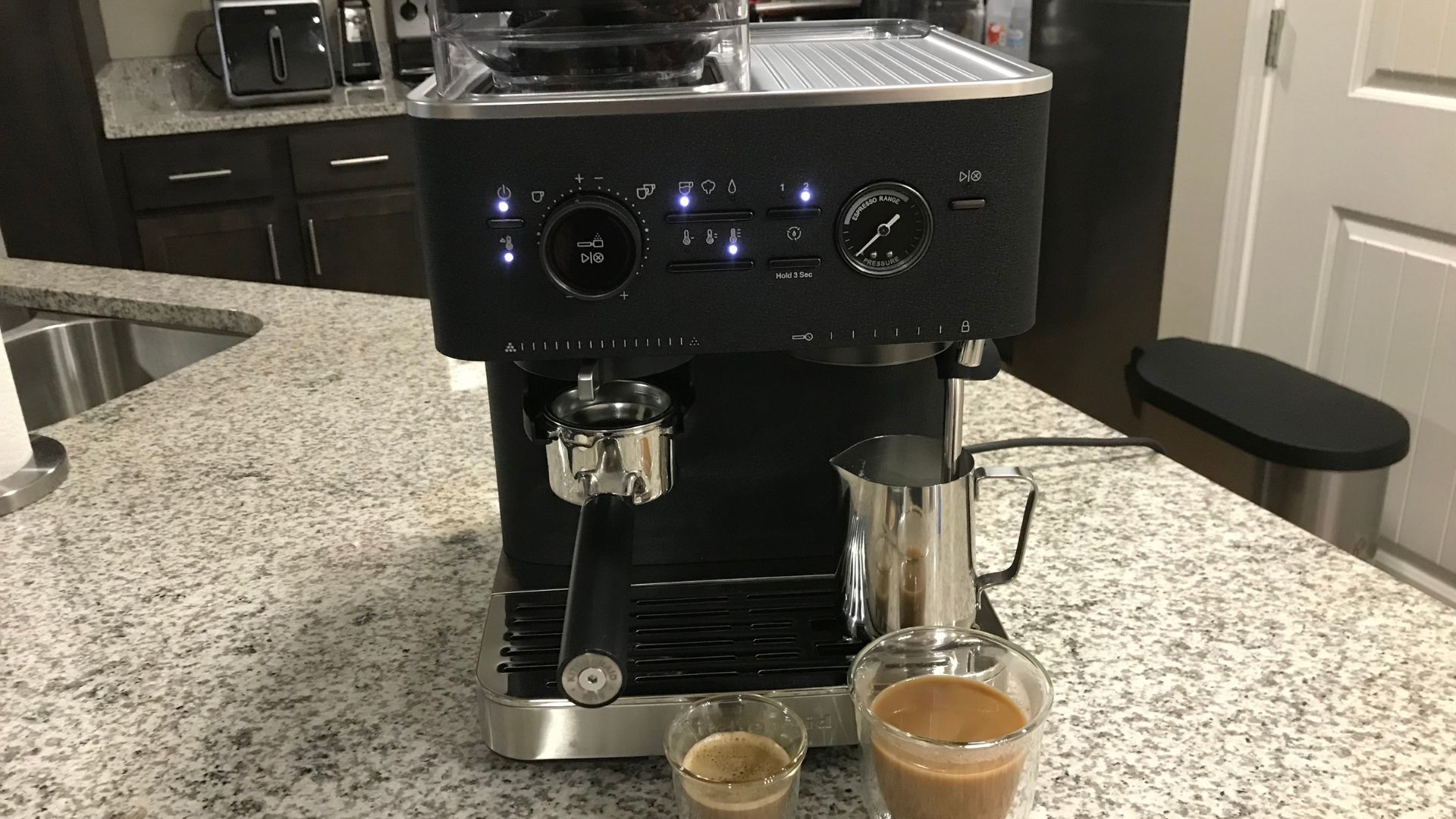
The noise level when grinding coffee beans is around 68.2 db. When making espresso, it's around 50 dB, which wasn't too bad.
Cleanup is interesting. It seems that the filter baskets don’t want to release the coffee grounds, so this led to me using a butter knife to dislodge the grounds. I’ve not met this level of resistance with filter baskets in other espresso machines. However, it’s not a huge inconvenience. Otherwise, the machine is easy to clean. The included Cleaning Brush makes it easy to get grounds out of the chute.
The Drip Tray, Milk Pitcher, Portafilter, and Filter Baskets can be washing in soapy water in the sink, and machine’s exterior, Cup Warmer Tray, Accessory Storage Tray, and Group Head can be wiped with a damp cloth. The Steam Wand is wiped with a damp cloth, and then I use Steam Mode to let it expel any remaining milk into the drip tray.
A descaling light comes up when the machine needs to be descaled. KitchenAid recommends using descaling solutions that are designed for semi-automatic espresso machines, but does not recommend a particular brand.
Score: 4.5 out of 5
KitchenAid Semi-Automatic Espresso Machine: User reviews
On Amazon, the KitchenAid Semi-Automatic Espresso Machine is currently listed as “new & notable” and has 24 ratings, with an average 4.4 rating. Amazon also notes that 100+ machines have been purchased in the past month. The vast majority of customers liked the design, functionality, and size. However, one person said it started auto descaling on it's own, and thought the heat and pressure were both weak, and sent the machine back to Amazon.
On KitchenAid’s website, there are 198 reviews and an overall 4.7 rating. Buyers loved the simplicity, taste, and felt that it was well-built, and quiet. The one negative review stated that all the lights came on and the machine would not work.
Should you buy the KitchenAid Semi-Automatic Espresso Machine?
| Attributes | Notes | Score |
|---|---|---|
| Price & availability | Expensive with has plenty bells and whistles | ★★★★ |
| Design | User friendly, and easy on the eyes | ★★★★★ |
| Performance | Works well, and has a gauge to guide you | ★★★★★ |
Buy it if...
Don't buy it if...
How does the L’OR Barista Coffee & Espresso System compare?
It's significantly more ($1,159.95), but the De’Longhi La Specialista Maestro also has an integrated burr grinder and bean hopper. In addition, it has a tamper station and five temperature controls (compared to KitchenAid's 3), along with a MyLatteArt Steam Wand, and automatic milk solution. However, it costs $1,159.95.
If your'e on a budget (and like capsules), consider the L'OR Barista ($189), which has plastic components and no milk frother, but does have double spouts, produces a crema layer, and uses a variety of both espresso and coffee capsules.
How I tested the KitchenAid Semi-Automatic Espresso Machine
I test the KitchenAid Semi-Automatic Espresso Machine off and on for a month, trying different sizes and using the water and steam functions.
When testing, I evaluated build quality, ease of use, performance, ease of cleaning, and, of course, taste.
Read more about how we test.
- First reviewed: May 2024